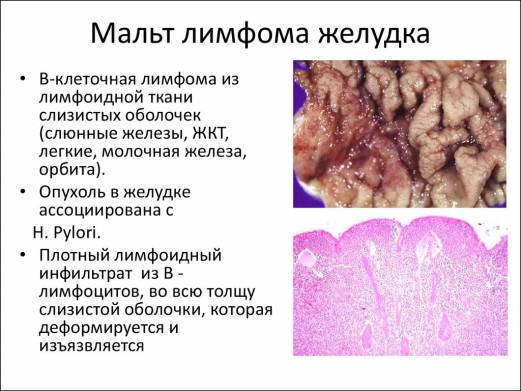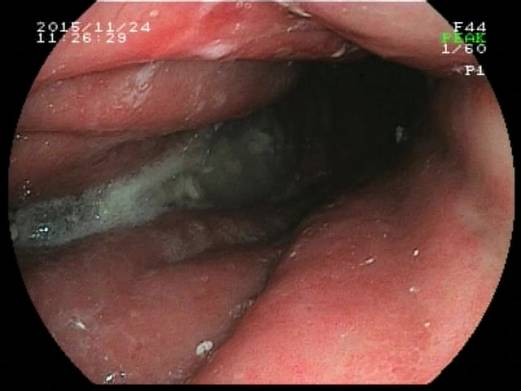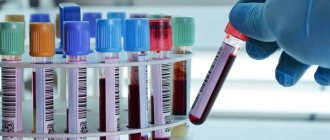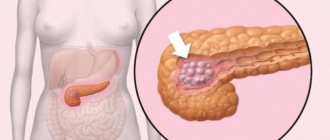Gastric lymphoma is a rare type of neoplasm of lymphoid tissue that is located in the wall of the stomach. Malignant lymphoma can cause nonspecific symptoms ranging from abdominal pain to severe nausea and vomiting. Diagnosis is made based on physical examination, imaging, and histological examination. Treatment options depend on the type of lymphoma and the patient's health. The prognosis varies greatly and depends on the extent, stage of lymphoma and comorbidities.
General information
A rare tumor, gastric lymphoma refers to lymphoproliferative processes that develop not in the lymph node, but in the tissues of the stomach. In the group of non-Hodgkin lymphomas, which are very diverse in cellular structure, the proportion of gastric localization is less than 8%.
There are no incidence statistics, but out of 100 thousand adults, gastric lymphoma develops in hardly 5-6 people, mainly in mature and elderly people. It has been noticed that men get sick more often.
Lymphomas are treated by oncohematologists, and the process in the gastrointestinal tract is diagnosed by oncologists, which is explained by the standards for routing a patient with a suspected tumor.
Treatment of lymphocytic gastritis
All treatment methods are divided into two large groups.
Non-drug therapy
This includes following a diet and quitting smoking and drinking alcohol.
The traditional method of treatment and maintaining results after treatment will be diet therapy.
Requirements for all therapeutic diets:
- Compliance with diet.
- Diet therapy should be complete and varied.
- Control over the correct processing of products.
- Concomitant pathology should be taken into account.
- Combining the diet with other principles of a healthy active lifestyle.
Principles of nutrition for chronic gastritis:
- Do not eat foods that mechanically irritate the stomach, for example, those containing large amounts of coarse vegetable fiber.
- Minimum chemical irritation caused by acidic foods.
- Avoid exposure to very cold and hot temperatures.
If chronic gastritis is detected in remission, diet 1 is indicated, developed specifically for patients with stomach diseases. Following a diet is necessary to accelerate the healing of erosions and reduce the activity of the inflammatory process.
Meals frequently, up to 6 times, in small portions.
Foods excluded from diet 1 if:
- pain occurs or intensifies.
- secretion increases. Products include fish and meat broths and sauces; mushrooms; salted, smoked, fried foods; pickled vegetables and fruits; spices.
The products are recommended to be boiled, baked, steamed and consumed in liquid, mushy and semi-solid form. Reduce salt intake as an irritant.
Meat and fish broths are excluded; soups are recommended to be prepared with vegetables.
It is recommended to avoid baked goods, canned food, sauces, and marinades. Carbonated drinks, coffee and dairy products are contraindicated.
It is recommended to follow the diet for up to 5 months, then gradually expand the range of permitted products.
Treatment with drugs
- Medicines that suppress secretion: H2-histamine receptor blockers (ranitidine, famotidine); proton pump inhibitors (omeprazole); antacid drugs (Almagel, Maalox, Gastal).
- Medicines that protect the gastric mucosa, for example, de-nol.
- Anti-Helicobacter drugs: antibacterial drugs.
- Regulators of motility of the digestive tract.
- Enzyme preparations.
- Herbal medicine: chamomile, yarrow, string, mint.
- Physiotherapy is recommended outside of an exacerbation and after consultation with a physiotherapist.
Surgical treatment is indicated if complications develop.
Causes of stomach lymphoma
The causes of the development of gastric lymphomas are unknown, and gene mutations leading to the degeneration of normal cells have not been identified. The family history of those suffering from gastric lymphomas often includes relatives with malignant diseases.
Immunity disorders are assumed to be involved in tumor initiation:
- excessive protection against allergies and autoimmune diseases;
- immunodeficiency due to HIV and hereditary syndromes;
- tolerance violations during antitumor therapy and chronic inflammation;
- depression due to increased radiation exposure.
A certain etiological role belongs to Helicobacter pylori infection; in most patients, Helicobacter pylori (H. pylori) is found in gastric secretions. Accumulations of B-lymphocytes in the gastric wall, from which a tumor develops, occur during chronic inflammation caused and maintained by bacteria. Detection of Helicobacter pylori infection and its treatment is a fundamental approach for the MALT (mucosal-associated) tumor variant.
Following actions
If the results of a gastric biopsy contain terms such as “atypical cells”, “cribrous structures”, “signet ring cells”, “carcinoma”, “cancer” and others, then you should not panic. To clarify the diagnosis, it is recommended to do a repeat gastroscopy with a biopsy (preferably in another clinic and with another doctor) and if oncological pathology is detected again, then only in this case should you contact an oncologist.
If a study was carried out on H. pylori and a biopsy confirmed the presence of these bacteria, complex eradication therapy using 3-4 drugs is prescribed. After 10-14 days, FGS must be repeated to evaluate the effectiveness of treatment.
Many people know that pain in the upper abdomen that occurs after eating food indicates inflammation of the gastric mucosa, gastritis. However, of the total number of people, only half were examined. Even fewer consulted a doctor and followed recommendations for treating the disease and preventing exacerbations and complications.
Due to the many different causes that cause gastritis, there are also quite a few varieties. Chronic gastritis is a dangerous disease characterized by processes of depletion or, conversely, proliferation of cells in the gastric mucosa against a background of low-grade inflammation. The danger lies in the inaction of a person with an identified pathology.
Chronic gastritis is classified in different ways, division option:
- Non-atrophic.
- Atrophic: autoimmune and multifocal.
- Special forms: lymphocytic, granulomatous, eosinophilic, hypertrophic, chemical, radiation.
There are forms that require more attention due to their low prevalence and considerable significance in the development of complications. These include lymphocytic gastritis.
Classification of gastric lymphomas
Lymphomas are heterogeneous in their cellular composition:
- The vast majority of 80% are tumors developing from B-lymphocytes of the marginal zone, or MALT lymphoma ; in some patients, H. pylori infection is found, which is in favor of a more favorable course.
- The remaining 20% are aggressive B-lymphocyte lymphomas or B-lymphomas , requiring difficult treatment with unenviable prospects for long life. Some researchers believe that this type of tumor results from transformation of a long-standing MALT lymphoma, as some patients have both types of tumor at the same time.
- The rarest type of benign tumor with possible transformation into aggressive B-lymphoma is pseudolymphoma , the process is localized only in the stomach, does not extend beyond its boundaries, and has a good prognosis for cure.
Staging of lymphomas is carried out not according to the usual oncological classification TNM or hematological Ann-Arbor, but according to Lugano, where the stage is:
- IE—small damage to the organ wall only;
- IIE - local tumor of the organ and nearby lymph nodes;
- IIIE - involvement of lymph nodes outside the abdominal cavity;
- IV - dissemination in the body.
Lymphoid infiltration of the stomach transcript
Inflammation of the gastric mucosa (gastritis) can come in different forms and types. One of the rare forms with a poorly understood etiology is lymphocytic gastritis, also known as lymphoid or lymphofollicular.
It is discovered during a laboratory morphological study of the gastric mucosa, which is significantly altered by lymphocytic infiltration (penetration of unusual particles).
We can talk about this infiltration when the number of lymphocytes (cells of the immune system) exceeds 30/100 in epithelial cells (cells lining the stomach).
Causes of lymphocyte infiltration
The function of intraepithelial lymphocytes is to collect and transmit information about the properties of food entering the stomach to cells of the immune system, which have a cytotoxic effect against bacteria supplied with food. For what reason lymphocytes mistakenly recognize the organ’s own cells as dangerous and attack them, disrupting and destroying the structure of tissues is unknown.
These processes are classified into the group of autoimmune (distorted immunity) diseases. There are hypotheses according to which the factors causing lymphocytic gastritis are:
- bacterium Helicobacter , capable of attaching to the gastric epithelium, creating its own colonies, damaging and creating chronic inflammation and causing an active reaction of lymphocytes to them;
- disruption of metabolic processes in the body, delay in the elimination of waste and toxins;
- hormonal imbalances leading to pathological manifestations;
- complications of infectious and viral pathologies.
People who are susceptible to one of the above reasons: often suffer from colds, take medications on their own without a doctor’s prescription, thereby injuring the gastric mucosa, breaking its protective barriers, suffer from gastritis, do not relieve them with medication, and neglect the rules of a healthy diet. So, they are at risk.
Risk factors
Risk factors are the causes of inflammation of the stomach of any form:
- Irregular intake of dry food with long breaks;
- frequent meals with fatty, vinegary, fried foods, using spices and seasonings;
- regular consumption of fizzy drinks containing dyes and preservatives;
- poisoning with chemical or medicinal reagents;
- abuse, frequent irritation of the gastric mucosa with alcohol and nicotine.
Type of disease
The representative of the local immunity of the stomach is lymphoid tissue. It consists of a number of cells (fibroblasts, reticular, plasma cells, lymphocytes of varying maturity, and others) and is represented by single or group follicles (limited clusters).
Lymphoid gastritis does not occur like all inflammations, due to a specific reason for irritation and destruction of the stomach lining, but in response to the natural fight carried out by lymphocytes. What is lymphoid gastritis? We can say that this is a certain stage of lymphocytic. After infiltration of leukocytes, their number further increases, and autoimmune reactions develop.
It is also called lymphofollicular gastritis; it always occurs against the background of chronic inflammation, concentration of lymphocytes, in the segment of the damaged area of the stomach.
Initially, it provides the process of saving the body, then the lymphocytic follicles grow, unevenly thicken the physiological gastric folds, disrupt the production of juice and can create areas of atrophy, leading to benign lymphoma.
Drug treatment
Only fibrogastroscopy . This diagnostic method, using a flexible optical probe, allows you to examine the walls of the stomach in detail, and most importantly, take the material for analysis.
According to the results of the examination, based on clinical manifestations, gastric motility disorders or changes in the concentration of hydrochloric acid, the following drug treatment is prescribed:
- Famotidine , Ranitidine (used to block histamine receptors to correct gastric secretion);
- Omeprazole , Parieta (proton pump inhibitor drugs that reduce acid dependence);
- Rennie , Maalox , Almagel , Phosphalugel (to neutralize aggression from hydrochloric acid);
- Dalargin , Metacil , Biogastron (protect against the appearance of new cracks or erosions);
- Creon , Mezim , Festal , Panzinorm (enzymatic assistance in digesting food);
- Amoxicillin , Amoxiclav , Azithromycin , Clarithromycin (antibiotics for stopping Helicobacter pylori bacteria);
- Lactiol , Motilium , Itomed , Domperidone (restore motility, stimulate a healthy rhythm of the stomach);
- De-nol (envelops the walls, protects against external irritations).
Source: https://tsitologiya.su/zheludok/limfoidnaja-infiltracija-zheludka-rasshifrovka
Symptoms of stomach lymphoma
Clinical manifestations of gastric lymphoma in the early stages are nonspecific and indistinguishable from the symptoms of carcinoma and ulcers. In various combinations, the following are possible: pain in the pit of the stomach, discomfort, heartburn, belching, feeling of heaviness after eating, loss of appetite, weight loss.
With a widespread process, the lymph nodes become enlarged, the lungs, intestines, liver, and spleen are affected.
Regardless of the size of the tumor, with the aggressive version of lymphoma, high fever with night sweats, weakness and rapid weight loss are possible - the so-called “B-symptoms”, indicating an unfavorable prognosis of lymphoma.
Gastric biopsy results: methods and interpretation
The average turnaround time for gastric biopsy results is from 5 to 14 days, depending on the workload of the pathology laboratory. At the end of the histological examination, the attending physician (sometimes the patient himself) receives a conclusion from a pathologist with a transcript on the basis of which treatment tactics are planned.
This article presents a transcript of the results of a gastric biopsy with a detailed description of each term that can be found in the conclusion.
Diagnosis of gastric lymphoma
Diagnosis of lymphoma at the first stage does not differ from the detection of other malignant processes of the stomach: endoscopy with biopsy, ultrasound, CT of the abdominal cavity, CT of the chest.
As with all malignant processes of the blood and lymphatic tissue, a bone marrow trephine biopsy is necessarily performed.
After morphological verification, diagnostics clarifying the therapy are carried out:
- tests for the detection of Helicobacter Pylori in gastric contents;
- the sensitivity of Helicobacter to antibiotics is determined;
- cytogenetic analysis to detect the transfer of the t(11;18) region from one chromosome to another; when a translocation is detected, a clarifying FISH analysis is performed.
Stages of the disease
There are four stages of gastric lymphoma, each of which has its own characteristics, the degree of penetration into the organ lining, and the clinical picture. Malt lymphoma detected at the initial stage has a good chance of cure, while the very last stage can cause death, despite the treatment measures taken.
- In the first stage of the disease, the oncological process does not extend beyond the stomach. Stage 1a is characterized by damage only to the mucous membrane, and at stage 1b the tumor invades the muscular and/or serous layer.
- In the second stage, regional lymph nodes on one side of the diaphragm and neighboring organs are affected by metastases.
- If the tumor has reached the third stage of development, then metastasis is noted in distant lymph nodes on both sides of the diaphragm, and the tumor itself infiltrates into organs located near the stomach.
- In the fourth stage, damage occurs to the lymph nodes and organs in any part of the body.
Treatment of gastric lymphoma
Treatment for MALT lymphoma and B-cell lymphomas differs significantly, with the latter requiring aggressive chemotherapy.
The treatment option for early-stage MALT lymphoma is determined by Helicobacter pylori infection; if it is present, then at the first stage antibacterial treatment is carried out, similar to the eradication of H.pilory in peptic ulcer disease.
The second stage depends on the results of the initial treatment:
- If H.pilory is resistant to antibiotics, the treatment regimen is changed; if the prognosis is unfavorable with t(11;18), targeted therapy with rituximab or radiation is added in parallel.
- When the gastric secretion is cleared of Helicobacter pylori infection and the lymphoma is completely regressed, the patient is observed with regular examinations according to the schedule.
- If there is a proven absence of infection and residual tumor, radiation to the stomach or monotherapy with rituximab is performed.
MALT tumors that have developed without the participation of Helicobacter and are limited to the gastric walls, especially in the presence of a chromosomal abnormality, are irradiated at the first stage; if radiation therapy is not possible, a course of targeted drug is given. Surgery to remove the stomach is performed only for lymphomas complicated by bleeding ulcers.
For advanced MALT lymphoma, preference is given to drug therapy.
Conservative and surgical treatment
Therapy for gastric lymphoma is carried out under the strict supervision of an oncologist, who develops a treatment strategy based on the type of tumor, prevalence and rate of progression of the disease. At each stage of lymphoma, its own therapeutic model is implemented:

If a patient is diagnosed with primary gastric lymphoma during examination, treatment can be carried out through surgery and chemotherapy. To reduce the risk of relapse, as a rule, an integrated approach is taken. The tumor is excised along with part of the gastric tissue, or a total gastrectomy is performed, that is, complete removal of the stomach. During the operation, nearby lymph nodes and organs are carefully examined. Distant metastases are removed using radiation therapy and a course of chemotherapy.- At the second stage of the disease, such powerful cytostatic drugs as Doxorubicin, Cytoxan, Vincristine are always used, and glucocorticoids are always included in the treatment course. The treatment regimen is chosen taking into account the specific nature of the course of the disease. Thus, large non-Hodgkin lymphoma is first reduced and only then removed.
- Once stage three or four is confirmed, splenectomy (removal of the spleen) may be necessary. The patient is prescribed a combination of x-ray and chemotherapy. The main task of doctors is to slow down the process of spread of tumor cells throughout the body. Radiotherapy is used only in affected areas where, after a course of chemotherapy, malignant cells, including bone tissue, could remain. A progressive method of fighting cancer is radioimmunotherapy. Radiation-tagged antibodies are injected into the body and destroy cancer cells without affecting healthy tissue.
If blood vessels are damaged or enlarged lymphoid follicles are detected, surgical intervention is not advisable. In such cases palliative therapy is prescribed , the purpose of which is to alleviate the symptoms of the disease and prolong the patient’s life. An inoperable patient is prescribed medications that relieve pain and improve the condition.
Separately, mention should be made of gastric lymphoma of Helicobacter origin. The method of its treatment is based on taking special medications that reduce inflammation and suppress the proliferation of bacteria. If drug therapy does not produce the desired effect, a course of radiation therapy and chemotherapy is carried out. The operation is prescribed in extreme cases. After recovery, a repeated antitumor course is recommended.
Since the disease is characterized by late invasion into the deep layers of the digestive organs and rare metastasis, with gastric lymphoma the chances of recovery are quite high . Erradication therapy allows achieving complete remission in 85% of patients and partial remission in 15%. The average five-year survival rate after radical surgery at the first stage of gastric lymphoma is 90%. At the second stage, this figure drops to 75%, and at the fourth - to 20%.
Complications
Any tumor in the stomach is characterized by complications:
- pain syndrome,
- ulceration with acute or chronic bleeding,
- perforation of the organ wall with the development of peritonitis.
In addition, with lymphoma, there may be a decrease in the specific gamma globulin IgG produced by normal immune cells, which contributes to frequent infections and inflammatory processes. The deficiency is compensated by intravenous administration of immunoglobulin.
In all cases, before starting chemotherapy, prevention of tumor lysis syndrome, which occurs when malignant cells are highly sensitive to drugs, is carried out.
Risk factors
Risk factors are the causes of inflammation of the stomach of any form:
- Irregular intake of dry food with long breaks;
- frequent meals with fatty, vinegary, fried foods, using spices and seasonings;
- regular consumption of fizzy drinks containing dyes and preservatives;
- poisoning with chemical or medicinal reagents;
- abuse, frequent irritation of the gastric mucosa with alcohol and nicotine.

Relapses
MALT lymphoma of the stomach has a slow course, however, as the stage increases, the likelihood of relapse increases. Starting from stage IIE, tumor recurrence is possible in every second patient, but the average period of relapse has not been determined due to the rare occurrence of the disease. The ability of some recurrent nodes to shrink without treatment—self-limitation—has been noted.
With aggressive lymphoma, relapses occur more often and remissions are shorter. In all situations, in case of relapse, chemotherapy is resorted to.
Lymphoid infiltration of the stomach - what is it?
Good afternoon, a year ago I asked you question No. 792510 antral gastritis and small intestinal metaplasia, I recently did a repeat FGD with a biopsy
The conclusion from FGDS is cardiac failure. erythematous gastropathy of the 1st degree of inflammation, erythematous duodenopathy of the 1st degree of inflammation.
The conclusion of the biopsy was chronic antral gastritis, lymphoid infiltration +, no activity, atrophy +, no intestinal metaplasia, no H pylori.
Please tell me what is lymphoid infiltration +? I am booked in for gastro in another 2 weeks; horror stories are written on the Internet that it is lymphoma of the stomach.
And I also wanted to ask, on some forums patients with atrophic gastritis write that they are recommended to undergo gastrectomy for such gastritis, that it is cancer, that low-grade cancer is difficult to detect, and that cancer cells will be found in the histology of the removed stomach.
Maybe I need to do a PET or CT scan? Should I also send the slides after the biopsy for histology?
Thank you very much for your answer
On Wednesdays, Vladimir Ivanovich is on duty. Questions will be answered with a delay of 2-3 days.
CREATE NEW MESSAGE.
But you are an unauthorized user.
If you register, you will be able to further track responses to your messages and continue the dialogue on interesting topics with other users and consultants. In addition, registration will allow you to conduct private correspondence with consultants and other users of the site.
The average turnaround time for gastric biopsy results is from 5 to 14 days, depending on the workload of the pathology laboratory. At the end of the histological examination, the attending physician (sometimes the patient himself) receives a conclusion from a pathologist with a transcript on the basis of which treatment tactics are planned.
This article presents a transcript of the results of a gastric biopsy with a detailed description of each term that can be found in the conclusion.
Biopsy techniques
In most cases, a small sample of the gastric mucosa obtained during gastroscopy is sent for pathohistological examination. Already in the laboratory, histological preparations are made from this fragment with a diameter of 3-5 mm, which are stained using various methods.
The benefits of gastroscopy with gastric biopsy are on the patient's side. This procedure is low-traumatic, minimally invasive and in some cases is not accompanied by any discomfort. However, from the point of view of a pathologist, such small gastric biopsies have a number of disadvantages:
Interpretation of biopsy results
The conclusion usually provides a description of the histological picture (cellular and tissue structure of the biopsy) and the pathomorphological diagnosis. Despite the existence of a clear method for deciphering the results of a gastric biopsy, many doctors give an insufficiently complete description. The table presents the main terms that can be found in the results and their characteristics:
Following actions
In the most modern Israeli clinic Top Ichilov, thanks to the use of the latest techniques and drugs, more than 90% of the clinic’s patients suffering from stomach cancer recover completely or achieve significant improvement and long-term remission.
Treatment of stomach cancer in Israel is carried out by world-class specialists who practice the latest methods of fighting cancer: chemotherapy, immunotherapy and biotherapy using the latest drugs that are selected individually for each patient in accordance with the results of advanced molecular genetic tests, a unique HIPEC chemotherapy technique that allows achieve better results and avoid side effects, the Da Vinci robotic surgical unit, with the help of which microsurgical operations of increased complexity are performed, and many others. You can find out more about treatment in Israel by filling out a request in the form below.
If a study was carried out on H. pylori and a biopsy confirmed the presence of these bacteria, complex eradication therapy using 3-4 drugs is prescribed. After 10-14 days, FGS must be repeated to evaluate the effectiveness of treatment.
Inflammation of the gastric mucosa (gastritis) can come in different forms and types. One of the rare forms with a poorly understood etiology is lymphocytic gastritis, also known as lymphoid or lymphofollicular.
It is discovered during a laboratory morphological study of the gastric mucosa, which is significantly altered by lymphocytic infiltration (penetration of unusual particles).
We can talk about this infiltration when the number of lymphocytes (cells of the immune system) exceeds 30/100 in epithelial cells (cells lining the stomach).
Classification of types of lymphoma
Depending on the course of the disease, the following types of pathology are distinguished:
- MALT is a lymphoma, that is, a lesion of the lymphoid tissue associated with the gastric epithelium. This disease is characterized by clearly limited single tumors and is not accompanied by symptoms characteristic of other carcinomas: bone marrow damage and lymphadenopathy, that is, inflammation of the lymph nodes. The pathology belongs to the class of non-Hodgkin's lymphomas;
- B-cell type of the disease. It is one of the most malignant and aggressive lymphomas. A tumor in this pathology is formed from primitive cells prone to uncontrolled division. Experts suggest that B-cell lymphoma may occur as a complication of MALT lymphoma;
- False lymphoma of the stomach. The most benign form of the disease, in which a lymphoid infiltrate is formed in the gastric mucosa. In most cases, the pathology is asymptomatic and does not cause discomfort to the patient. Malignancy is observed only in isolated cases.

There is also a classification of the disease according to its origin:
- Non-Hodgkin's lymphoma. The most extensive group, the pathologies included in it differ in the level of malignancy. The appearance of lymphomas of this type in most cases is associated with exposure to the patient’s body of the bacterium Helicobacter pylori;
- Lymphogranulomatosis or Hodgkin's lymphoma is a malignant pathology in which malignant cells from the affected lymph node enter the stomach with the bloodstream and provoke tumor processes in its tissues;
- Lymphomatosis is hyperplasia, that is, proliferation of lymphoid tissue with the formation of an infiltrate in the wall of the stomach. With lymphomatosis, the patient is diagnosed with “false lymphoma.”
Depending on the structure of the tumor, the disease is divided into three groups. Exophytic, that is, growing into the lumen of the organ. Depending on the appearance of the neoplasm, the following are distinguished:
- Plaque-like;
- Polypoid;
- Nodal;

Infiltrative, in which the mucous and submucosal layer of the stomach is affected:
- Flat-infiltrative;
- Gigantofold;
- Gastritis-like – causes erosive processes of the epithelium, often develops against the background of chronic gastritis;
- Ulcerative is the most aggressive and dangerous type of lymphoma, leading to rapid degenerative changes in stomach tissue;
- Mixed.
Diet
During treatment for gastric lymphoma, as well as during the rehabilitation period, it is very important to follow a special diet, which should be prescribed by a nutritionist. Sometimes you have to not just adjust your diet, but completely change it. Constant pain with lymphoma significantly reduces appetite, but hunger can only worsen the situation. All patients, regardless of the stage of the disease and its type, need to reduce, or even better, completely eliminate animal protein from the menu. Preference should be given to a large amount of fermented milk and fresh vegetables.
Nutrition for gastric lymphoma should be balanced and include all the vitamins and nutrients the body needs. Nutritionists recommend sticking to approximately the following menu:
- 1st breakfast - dietary boiled meat cutlets, rice, omelette, green tea;
- 2nd breakfast - mashed cottage cheese or applesauce;
- lunch - vegetable soup in the form of puree, boiled lean fish or chicken, fruit juice;
- afternoon snack - homemade yogurt or fresh fruit (vegetable) juice;
- dinner - boiled durum wheat pasta and cheese or cereal porridge with chicken breast.
A balanced diet will help the body fight the disease, and the patient will recover faster.








